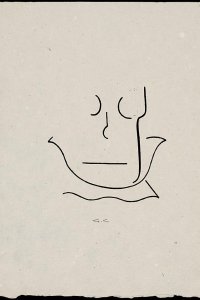Cimetière marin
- Year:
- 1945
- Author:
- Paul Valéry (1871 - 1945)
- Artist:
- Gio Colucci (1892 - 1974)
- Publisher:
- À l'enseigne de la Trirème
Beginning and end
The last verse of this poem reads 'Ce toit tranquille où picoraient les focs' (this quiet roof that was stung by the sails). It is a variation of the first verse of the poem, that speaks of the sea with the words: 'Ce toit tranquille où marchent des colombes' (this quiet roof, where the doves walk). Like the last verse, the last illustration seems to point to this first verse: in it, the roof has been replaced by the sea.
This is not the very last illustration in the book; the poem ends with an illustration of the sea with the word 'Fin' (The end) in the centre. Then follows the illustration of the colophon, the text of which is set in the form of a fir tree and printed on top of an illustration of another fir tree. In the background, several trees have been highlighted ina bright yellow colour. Colucci used pastels throughout the collection, sometimes in surprising combinations such as pink and green.
Gio Colucci's life
Colucci was born in Florence. He studied architecture in Paris and worked as an architect in Cairo during World War I. After the war, he became a painter and ceramist. He illustrated a large number of books, most of them self-published, with texts by, among others, Dante, Barbey d'Aurevilly and Pierre Loti. His illustrations show a wide variety of styles.
Little is known of his personal life. In an announcement for the auction at Hôtel Drouot's on 1 March 1971, Guy Dormand described him as follows: 'A Christian seized by Buddhism, who in fifteen years has evolved from expressionism in the style of Charles Dufresne to an enormous euphoria of colour. His works bear witness to one of the most original artists of his time'.
Bibliographical description
- Description:
- Cimetière marin / Paul Valéry ; ill. par Gio Colucci. - [Paris] : À l'enseigne de la Trirème, 1945. - [55] p. : ill. ; 34 cm. - (Monumentale ; 3)
- First edition:
- 1920
- Printer:
- P. Mersch, L. Seitz & Co., Parijs (text) ; Gio Colucci (illustrations)
- Edition:
- 160
- This copy:
- No. J of 10 on Arches with a extra set of the illustrations on Chiffon and an original illustration, signed by Gio Colucci
- Bibliography:
- Carteret IV-385 ; Monod-10867
- Shelfmark:
- KW KOOPM K 346
References
- E. Bénézit, Dictionnaire critique et documentaire des peintres, sculpteurs, dessinateurs et graveurs de tous les temps et de tous les pays par un groupe d'écrivains spécialistes français et étrangers; 3, Paris, Gründ, 1999
- Jean-Pierre Delarge, Dictionnaire des arts plastiques modernes et contemporains, Paris, Gründ, 2001
- Marcus Osterwalder, Dictionnaire des illustrateurs; III, Paris, Bibliothèque L'Heure joyeuse, 2005

![Paul Valéry, Cimétière marin (1945), p. [5]](/sites/default/files/styles/galerie/public/images/cimetiere_marin_p5.jpg?h=825eb4f8&itok=1IROwcSr)
![Paul Valéry, Cimétière marin (1945), p. [30]-[31]](/sites/default/files/styles/galerie/public/images/cimetiere_marin_p30-31.jpg?h=158b8f82&itok=WadE_PNJ)
![Paul Valéry, Cimétière marin (1945), p. [46] en [51]](/sites/default/files/styles/galerie/public/images/cimetiere_marin_p46-51.jpg?h=784e3e17&itok=rkgTRNOq)

